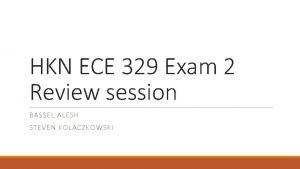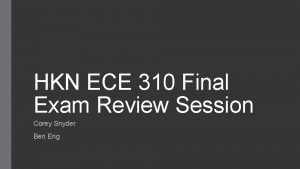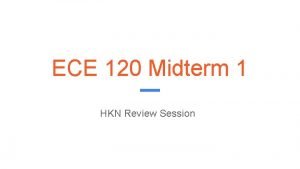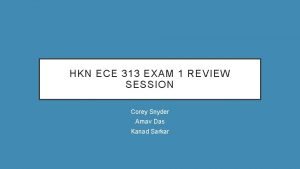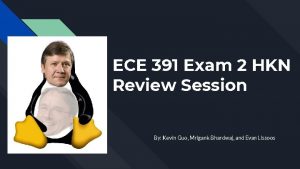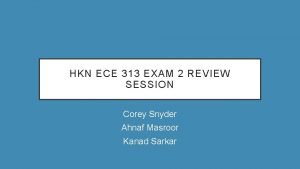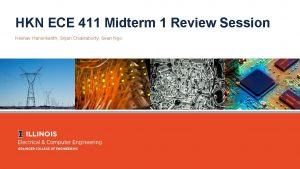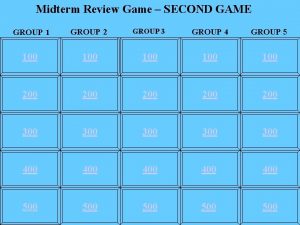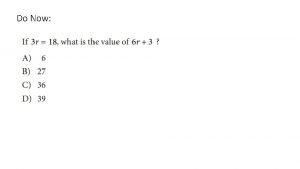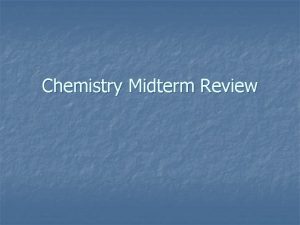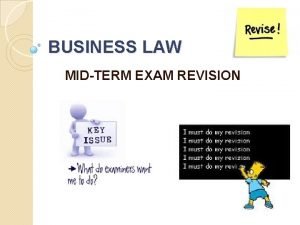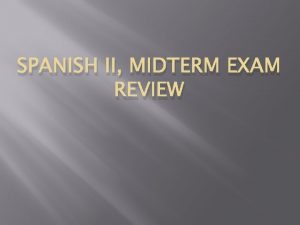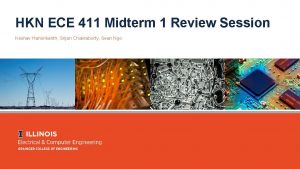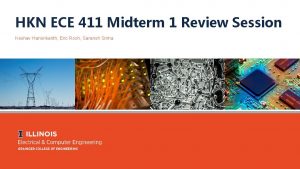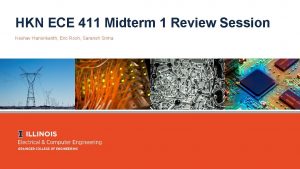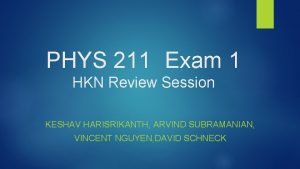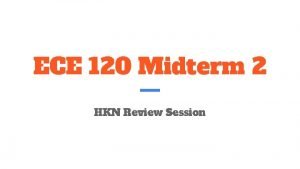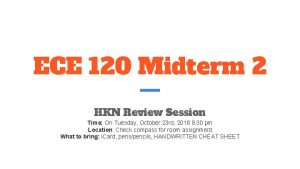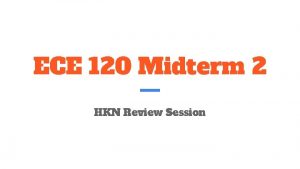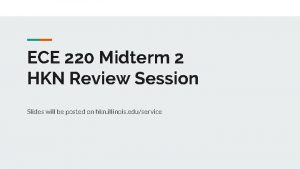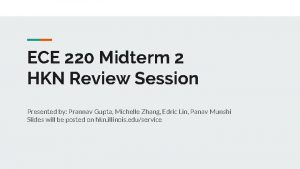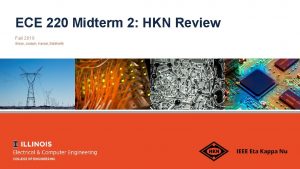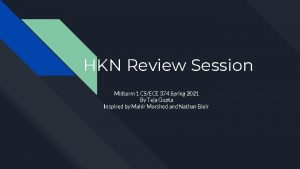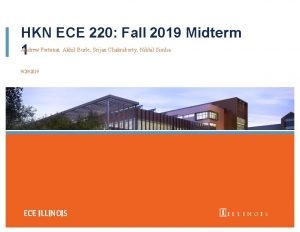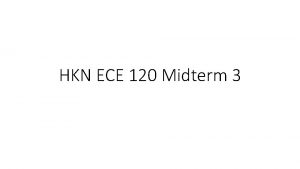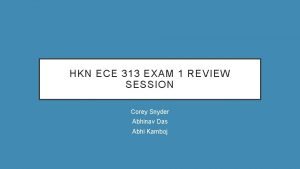HKN ECE 411 Midterm 1 Review Session Keshav























- Slides: 23

HKN ECE 411 Midterm 1 Review Session Keshav Harisrikanth, Srijan Chakraborty, Sean Ngo

Agenda § § § § Architecture Concepts Instruction Set Architecture (ISA) Performance, Energy, Power Memory Hierarchy Caches Virtual Memory (VM) Pipelines and Hazards MPs

Architecture Concepts § Dennard Scaling – Same area, same power, smaller and faster transistors § von Neumann Architecture § RISC vs CISC (fixed vs. variable length) 3

Instruction Set Architecture § 5 Basic types of ISA: § Tradeoffs? – Accumulator – Stack – Mem-Mem – Reg-Mem – Load-Store § Other design considerations: – Fixed vs variable instr. length, register count, number of opcodes 4

ISA (cont. ) • Be able to: Convert between any ISAs Evaluate performance • • HW and SW Consider new ISAs • Larger ISA Categories • • 5 RISC vs. CISC REG vs MEM stack accumulator push A push B add pop C load A add B store C register (register-memory) load R 1, A add R 1, B store C, R 1 register (loadstore) load R 1, A load R 2, B add R 3, R 1, R 2 store C, R 3

Performance § 6

Energy & Power § 7

Memory Hierarchy § 8

Caches § Types of Caches – Direct Mapped • Memory Value can be placed at a single corresponding location in cache • Fast Indexing mechanism 9

Caches § Types of Caches – Set Associative (Two way in image) • Memory Value can be placed into a set of locations in cache • More complex mechanism 10

Caches § Types of Caches – Fully Associative • Memory Value can be placed into any location in cache • Very complex mechanism required to search cache such as CAM 11

Cache Characteristics § Three C’s – Compulsory Misses: Cold start misses (no valid data at start) – Capacity Misses: Cache is full, and needs to evict – Conflict Misses: Wrong tag at index, cache may not be full § Replacement Policies – Least Recently Used (LRU, p. LRU) – Not Most Recently Used (Not-MRU) – Least Frequently Used (LFU) 12

Virtual Memory § Num bits VPN ≥ PPN § More addressable space than physical memory § Homonym Problem: – 1 Virtual Address maps to multiple Physical Addresses § Synonym Problem: – Multiple Virtual Addresses map to 1 Physical Address 13

Virtual Memory § Homonym Solution: § Num bits VPN ≥ PPN – Flush TLB and caches on § More addressable space context switch than physical memory § Synonym Solution: § Homonym Problem: – Depends on cache size and – 1 Virtual Address maps to multiple Physical Addresses § Synonym Problem: – Multiple Virtual Addresses map to 1 Physical Address 14 page size

VIVT Cache § Virtually-Indexed, Virtually-Tagged (VIVT) – Very fast access time – Susceptible to homonym and synonym problem 15

PIPT Cache § Physically-Indexed, Physically-Tagged (PIPT) – Slower access time – Not susceptible to homonym and synonym problem – Simpler coherence 16

VIPT Cache § Virtually-Indexed, Physically-Tagged (VIPT) – Very fast access time (Parallelize TLB and Cache) – Not susceptible to homonym • Synonym problem remains under certain conditions 17

Address Translation § Page Table Walk § Be prepared for 391 -esque page table/entry sizing. § Be able to break down address as used. § Flat vs n-Level – 2 Level for x 86 18

Pipelining § What can be pipelined? § Why does pipelining improve performance? § What extra considerations do pipelines add? – Hazards (and their various solutions) § The “Classic” 5 Stage RISC Pipeline: 19

Hazards Structural – Limitation on functional units. Data – Same data has different values at different stages. Control – Control flow of the program is incorrect. – Branch prediction. 20

MPs: MP 1 § System. Verilog Proficiency – Tasks, Functions – Procedural Statements – Be able to trace a waveform with SV. § Verification fundamentals – Stressing input stimuli – Error reporting 21

MPs: MP 2 § RISC-V § Memory structures – Alignment § Multicycle processors § For more, take ECE 385 22

Questions? 23
 Hkn review session
Hkn review session Direct form 2 structure
Direct form 2 structure Ece 120 wiki
Ece 120 wiki Ece 313
Ece 313 Hkn review session
Hkn review session Ece 391
Ece 391 Corey snyder uiuc
Corey snyder uiuc Ece 411
Ece 411 Rudra environmental solution
Rudra environmental solution Keshav puttaswamy
Keshav puttaswamy Keshav pingali
Keshav pingali B2 keshav puram
B2 keshav puram Pons mnemonic
Pons mnemonic Algebra 1 midterm exam
Algebra 1 midterm exam Whap midterm review
Whap midterm review Cows
Cows Global 9 midterm review
Global 9 midterm review Trig midterm review
Trig midterm review Chemistry midterm review
Chemistry midterm review Business law midterm exam answers
Business law midterm exam answers Apes midterm practice test
Apes midterm practice test Ap chemistry midterm exam
Ap chemistry midterm exam Algebra 2 midterm review answers
Algebra 2 midterm review answers Spanish 2 midterm practice test
Spanish 2 midterm practice test
